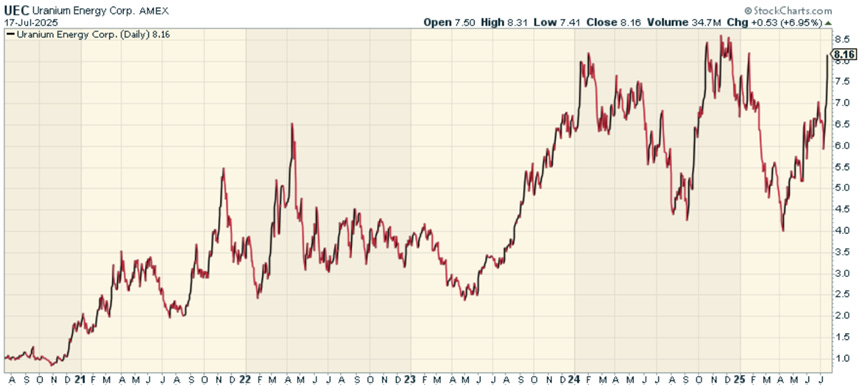Inside $FMKT's Bold Move: Why UEC Is A Top holding
The uranium market is facing a fundamental supply-demand imbalance that I think creates one of the more compelling investment opportunities in the commodity space right now. Nuclear reactors currently generate about 19% of the nation's electricity across 94 operating reactors at 54 commercial power plants in 28 states. Yet last year's global uranium production came in at roughly 150 million pounds while reactors consumed 165 million pounds, with demand projected to reach 230 million pounds by 2030.
That's a widening gap that doesn't look sustainable without significant price increases.
The regulatory backdrop makes this story even more interesting. Since 1978, the Nuclear Regulatory Commission has only approved five new reactors, with just two actually built at Georgia's Vogtle plant. This regulatory stranglehold has essentially kept the nuclear industry in a holding pattern for decades, but that dynamic appears to be shifting.
As the first ETF specifically designed to capitalize on deregulation beneficiaries, The Free Markets ETF (Ticker: FMKT) currently has Uranium Energy Corp (UEC) as a top holding. This choice reflects something important about where the market might be headed, and is a good example of why I helped bring the fund to market as a way to capitalize on new investment opportunities that deregulation can bring to the economy and individual stocks.
The story here is about more than just supply and demand fundamentals. With Trump pursuing an aggressive deregulation agenda, companies like UEC could see multiple tailwinds working in their favor. FMKT's emphasis on regulatory beneficiaries makes it an intriguing play for investors who want exposure to this theme without having to pick individual uranium stocks, while also having exposure to non-Uranium companies that are beneficiaries to their own deregulation catalysts.
The Deregulation Wave: Nuclear Policy Gets A Complete Overhaul
Image Source: Manhattan Institute
Nuclear energy regulation is undergoing its most significant transformation in decades. President Trump signed four groundbreaking executive orders in May 2025 specifically designed to jumpstart America's nuclear energy industry. These orders represent a fundamental shift in how the government approaches nuclear power, creating what could be substantial opportunities for investors in the uranium sector.
The NRC Gets A Complete Makeover
The executive orders call for a comprehensive restructuring of the Nuclear Regulatory Commission (NRC), requiring approvals of new nuclear reactor designs to be completed in no more than 18 months. They also mandate a wide-ranging revision of regulations conducted in conjunction with the White House. The regulatory overhaul aims to quadruple nuclear generation in the United States by 2050, from around 100 GW today to 400 GW.
The NRC has already begun implementing changes in accordance with these orders. Most visibly, the agency has rescinded diversity, equity, and inclusion policies that were deemed inconsistent with Executive Orders 14151 and 14168. The administration is now directing the NRC to consider the benefits of nuclear power to economic and national security, not just public health and safety.
What This Means For Uranium Mining And Reactor Development
For uranium mining, these deregulatory actions simplify the process for recovering or disposing of uranium from inactive mining sites. The NRC is now reviewing license applications for technologies like high-pressure slurry ablation (HPSA), which can remediate thousands of abandoned uranium mines throughout the western United States.
Reactor licensing has been streamlined significantly. The executive orders instruct the NRC to create an expedited pathway to approve reactors that have been safely tested by the Department of Energy or Department of Defense. This represents a marked departure from previous decades when only two new reactors were ordered and brought online since 1978.
The Investment Implications Are Pretty Clear
If these regulatory changes stick, the investment landscape for uranium stocks changes dramatically. The Free Markets ETF (FMKT) has positioned itself as the first investment vehicle specifically designed to capitalize on Trump's deregulation push. FMKT's portfolio strategically includes companies facing regulatory burdens that stand to benefit from streamlined processes.
FMKT selected Uranium Energy Corp (UEC) as one of its largest holdings. This strategic decision reflects UEC's potential to benefit from increased domestic uranium production - a key priority of the executive orders that aim to reduce dependence on foreign uranium sources.
The bottom line is that deregulation creates a completely different operating environment for nuclear companies. If the 18-month approval timeline becomes reality and the regulatory burden gets lightened substantially, companies like UEC could see multiple catalysts working in their favor simultaneously.
FMKT's Strategic Bet: Picking Deregulation Winners
FMKT represents something different in the ETF space - the first fund built around regulatory exposure rather than traditional sector classifications. The Free Markets ETF has essentially created a new investment category focused on companies that could benefit from reduced regulatory burden.
The FMKT Investment Framework
What makes FMKT unique is its approach to portfolio construction. Instead of buying companies based on what they do, FMKT buys them based on what's holding them back. This means looking at regulatory intensity rather than market cap or revenue growth. It's a fundamentally different way to think about building a portfolio.
The fund's methodology identifies companies across multiple sectors that share one common trait - they're weighed down by regulatory complexity. This creates an interesting opportunity when those regulatory barriers start coming down.
Why UEC Made the Cut
Among uranium companies, UEC secured a prime spot in FMKT's portfolio based on several factors. The company's debt-free balance sheet gives it operational flexibility that many competitors lack. Its shovel-ready projects mean it can respond quickly to regulatory changes. Most importantly, we believe UEC is positioned to benefit immediately from any streamlining of uranium mining regulations.
For investors who don't want to pick individual uranium stocks, FMKT offers direct exposure to UEC alongside other deregulation beneficiaries. This provides diversification while maintaining the regulatory theme.
How This Differs from Traditional Energy ETFs
Traditional energy ETFs typically mix everything together - oil, gas, renewables, utilities. They weight holdings based on market cap or equal allocation across subsectors. FMKT takes a different approach by evaluating companies based on their regulatory burden intensity and potential upside from regulatory relief.
This distinction matters because it creates a more focused investment thesis. Instead of betting on energy broadly, you're betting on regulatory change specifically. That makes FMKT particularly attractive for investors who believe regulatory streamlining will be a major market driver.
UEC's Unique Position In The Uranium Market
Source: StockCharts.com as of 7/17/25
UEC has carved out what I consider one of the most compelling positions in the uranium space. The company's combination of strategic assets and operational readiness sets it apart from most competitors in ways that directly align with FMKT's investment thesis.
Production Capacity When It Matters Most
UEC holds America's largest licensed production capacity at 12.1 million pounds of U3O8 per year, operating across three hub-and-spoke production platforms in Wyoming and Texas. The company successfully restarted uranium production at its Christensen Ranch ISR operation in Wyoming in August 2024. This isn't just about having assets - it's about having assets that can actually produce when the market needs them.
The Balance Sheet Advantage
Zero debt with significant cash. That's the kind of financial flexibility that becomes incredibly valuable when commodity cycles turn. The company's focus on low-cost in-situ recovery (ISR) mining further enhances its cost advantage, which matters more in a supply-constrained market than most people realize.
Strategic Positioning In Domestic Supply
America consumes 47 million pounds of uranium annually, yet domestic production has been minimal for years. UEC's recent supply agreements with next-generation reactor developers including Radiant Industries and TerraPower position the company as a key supplier to the U.S. Strategic Uranium Reserve. This domestic focus becomes particularly relevant given the current geopolitical backdrop.
Unhedged Exposure To Price Movements
Unlike many producers, UEC remains 100% unhedged with full spot market exposure. This provides maximum leverage to uranium price increases in a market facing a projected supply deficit of more than 886 million pounds between 2025-2040. It's a higher-risk, higher-reward proposition that could pay off significantly if the supply-demand fundamentals play out as expected.
The Rio Tinto Acquisition
UEC's USD 175 million purchase of Rio Tinto's Wyoming assets, including the fully-licensed Sweetwater Plant, represents more than just expansion. This third hub-and-spoke platform adds approximately 175 million pounds of additional historic resources and solidifies UEC's position as America's leading uranium developer.
The combination of production readiness, financial strength, and strategic positioning explains why FMKT selected UEC as a cornerstone holding. For investors seeking uranium exposure through FMKT, UEC offers what I consider pure exposure to the sector's potential upside without the typical development risks that plague many uranium companies.
The FMKT Approach: Balancing Risk and Opportunity
For investors who don't want to pick individual uranium stocks, FMKT offers balanced exposure while emphasizing deregulation winners like UEC. This approach captures both immediate production advantages and regulatory tailwinds without requiring specialized industry knowledge.
UEC's combination of production readiness, unhedged position, and strategic U.S. assets creates what I think is a compelling investment case. That explains its prominence in FMKT's portfolio.
The Bottom Line On FMKT's Uranium Play
The uranium market is setting up for what could be a significant supply crunch over the next several years. That much seems clear from the production data and demand projections we're seeing. What's less certain is how quickly the regulatory environment will actually change and whether companies like UEC can capitalize on those shifts.
I helped design FMKT to have an approach that makes sense and is smart. Rather than trying to pick individual uranium stocks, the fund is designed to invest based on the broader deregulation theme while getting exposure to what appears to be one of the better-positioned companies in the space. UEC's debt-free balance sheet and unhedged position give it flexibility that a lot of its competitors don't have.
The nuclear sector specifically looks like it could be entering a different phase. Those executive orders aimed at quadrupling nuclear generation by 2050 represent a real shift in how the government views this industry. Whether that translates into actual results remains to be seen, but the regulatory tailwinds are starting to line up.
For investors who want uranium exposure without the complexity of evaluating individual mining companies, FMKT offers an interesting alternative. The fund's focus on regulatory beneficiaries means you're not just betting on uranium prices - you're betting on the broader theme of deregulation across multiple sectors.
The risk, of course, is that policy changes take longer to implement than anyone expects. But given the supply-demand dynamics in uranium and the changing regulatory landscape, I think there's a reasonable case for considering both UEC directly and FMKT as a way to play this theme.
Past performance is no guarantee of future results.
The Fund’s investment objectives, risks, charges, expenses and other information are described in the statutory or summary prospectus, which must be read and considered carefully before investing. You may download the statutory or summary prospectus or obtain a hard copy by calling 855-994-4004 or visiting www.freemarketsetf.com. Please read the Prospectuses carefully before you invest.
Investing involves risk including the possible loss of principal.
FMKT is distributed by Foreside Fund Services, LLC.
Find full holding details and learn more about FMKT at http://www.freemarketsetf.com.
Holdings are subject to change.
Deregulation Strategy Risks.The Fund’s strategy of investing in companies that may benefit from deregulatory measures entails significant risks, including those stemming from the unpredictable nature of regulatory trends. Deregulation is influenced by political, economic, and social factors, which can shift rapidly and in unforeseen directions. Changes in government priorities, political leadership, or public sentiment may result in the reversal of existing deregulatory policies or the introduction of new regulations that could adversely affect certain industries or companies. Further, while the Fund invests in companies expected to benefit from deregulatory initiatives, not all of these companies may achieve the expected advantages, whether fully, partially, or at all. The actual impact of deregulatory measures may vary widely depending on a company’s specific operational, financial, and competitive circumstances. Companies may also face challenges adapting to new regulatory environments, or their competitive positioning may be undermined by other market factors unrelated to deregulation. These risks could negatively affect the performance of the Fund’s portfolio.
Underlying Digital Assets ETP Risks. The Fund's investment strategy, involving indirect exposure to Bitcoin, Ether, or any other Digital Assets through one or more Underlying ETPs, is subject to the risks associated with these Digital Assets and their markets. These risks include market volatility, regulatory changes, technological uncertainties, and potential financial losses. As with all investments, there is no assurance of profit, and investors should be cognizant of these specific risks associated with digital asset markets.
● Underlying Bitcoin and Ether ETP Risks: Investing in an Underlying ETP that focuses on Bitcoin, Ether, and/or other Digital Assets, either through direct holdings or indirectly via derivatives like futures contracts, carries significant risks. These include high market volatility influenced by technological advancements, regulatory changes, and broader economic factors. For derivatives, liquidity risks and counterparty risks are substantial. Managing futures contracts tied to either asset may affect an Underlying ETP's performance. Each Underlying ETP, and consequently the Fund, depends on blockchain technologies that present unique technological and cybersecurity risks, along with custodial challenges in securely storing digital assets. The evolving regulatory landscape further complicates compliance and valuation efforts. Additionally, risks related to market concentration, network issues, and operational complexities in managing Digital Assets can lead to losses. For Ether specifically, risks associated with its transition to a proof-of-stake consensus mechanism, including network upgrades and validator centralization, may add additional uncertainties.
●Bitcoin and Ether Investment Risk: The Fund's indirect investments in Bitcoin and Ether through holdings in one or more Underlying ETPs expose it to the unique risks of these digital assets. Bitcoin's price is highly volatile, driven by fluctuating network adoption, acceptance levels, and usage trends. Ether faces similar volatility, compounded by its reliance on decentralized applications (dApps) and smart contract usage, which are subject to innovation cycles and adoption rates. Neither asset operates as legal tender or within central authority systems, exposing them to potential government restrictions. Regulatory actions in various jurisdictions could negatively impact their market values. Both Bitcoin and Ether are susceptible to fraud, theft, market manipulation, and security breaches at trading platforms. Large holders of these assets ("whales") can influence their prices significantly. Forks in the blockchain networks—such as Ethereum's earlier split into Ether Classic—can affect demand and performance. Both assets' prices can be influenced by speculative trading, unrelated to fundamental utility or adoption.
● Digital Assets Risk: Digital Assets like Bitcoin and Ether, designed as mediums of exchange or for utility purposes, are an emerging asset class. Operating independently of any central authority or government backing, they face extreme price volatility and regulatory scrutiny. Trading platforms for Digital Assets remain largely unregulated and prone to fraud and operational failures compared to traditional exchanges. Platform shutdowns, whether due to fraud, technical issues, or security breaches, can significantly impact prices and market stability.
● Digital Asset Markets Risk: The Digital Asset market, particularly for Bitcoin and Ether, has experienced considerable volatility, leading to market disruptions and erosion of confidence among participants. Negative publicity surrounding these disruptions could adversely affect the Fund's reputation and share trading prices. Ongoing market turbulence could significantly impact the Fund's value.
● Blockchain Technology Risk: Blockchain technology underpins Bitcoin, Ether, and other digital assets, yet it remains a relatively new and largely untested innovation. Competing platforms, changes in adoption rates, and technological advancements in blockchain infrastructure can affect their functionality and relevance. For Ether, the dependence on its proof-of-stake mechanism and smart contract capabilities introduces risks tied to network performance and scalability. Investments in blockchain-dependent companies or vehicles may experience market volatility and lower trading volumes. Furthermore, regulatory changes, cybersecurity incidents, and intellectual property disputes could undermine the adoption and stability of blockchain technologies.
Recent Market Events Risk. U.S. and international markets have experienced and may continue to experience significant periods of volatility in recent years and months due to a number of economic, political and global macro factors including uncertainty regarding inflation and central banks’ interest rate changes, the possibility of a national or global recession, trade tensions and tariffs, political events, war and geopolitical conflict. These developments, as well as other events, could result in further market volatility and negatively affect financial asset prices, the liquidity of certain securities and the normal operations of securities exchanges and other markets, despite government efforts to address market disruptions.
New Fund Risk. The Fund is a recently organized management investment company with no operating history. As a result, prospective investors do not have a track record or history on which to base their investment decisions.
. Lead-Lag Publishing, LLC is not an affiliate of Tidal/Toroso, Tactical Rotation Management, LLC, SYKON Asset Management, Point Bridge Capital, or ACA/Foreside.




